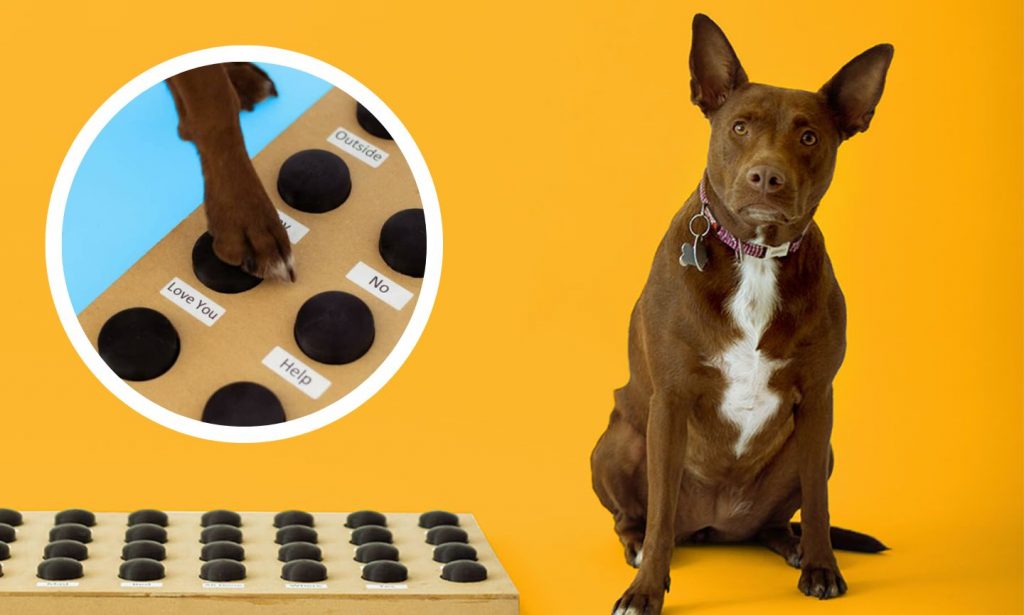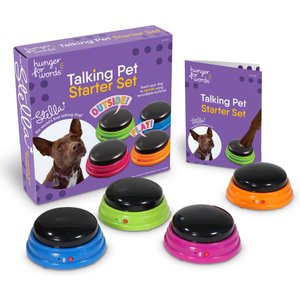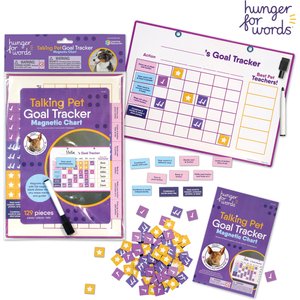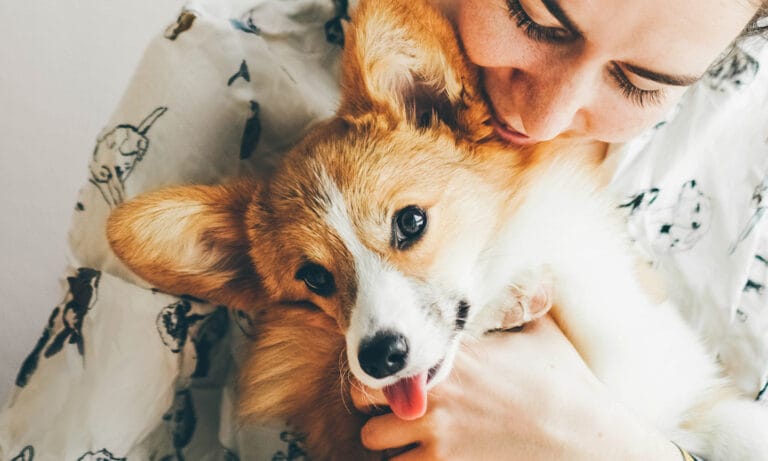When dogs want to communicate to their parent that they want to go outside, they might walk over to the door and scratch at it. When Stella tells her mom Christina Hunger she wants outside, the Catahoula-Blue Heeler-mix uses her “words.”
In a now-viral Instagram video from 2019, Stella is shown pressing a series of buttons her mom assembled for her on the floor: "Happy. Ball. Want. Outside," she "tells" Hunger. And while Stella might be the first dog to go viral for “talking,” she’s far from the last.
Teaching your dog to talk with buttons is not only a fun bonding experience, but it also provides another opportunity for communication and empowers dogs to make their own choices. But can any dog learn how to “talk” with buttons? And is it easy to do? Yes! And we’ll show you how.
Click on a button to jump to that section:
How Do Dog Buttons Work?
Words and phrases programmed onto these buttons can include anything and everything, from “food” and “outside” to “love you!” Pets can even combine words together to create phrases and short sentences.
“Dogs can communicate their wants, needs, thoughts, feelings, questions and observations about their environment using speech buttons,” says Hunger, speech-language pathologist and the creator of Hunger for Words talking buttons and accessories.
Learn more about the science behind talking dog buttons at PetMD.
How Do I Teach My Dog to Use Talking Pet Buttons?
1Start with a couple simple words your dog already knows.
Starting with one or two buttons, choose words your dog is already familiar with, like potty, play, walk or eat. As long as the words are about patterns or routines that already exist in your dog’s life, you’re good to go. Record the words onto the buttons. (And remember, you record just one word per button.)
2Model words for your dog.
Modeling the words is one of the most important steps. This means using your dog’s buttons in the right contexts naturally and organically throughout the day. This means, you do not need to dedicate 10 or 20 minutes each day to button training.
For example, before you go outside, press the “outside” button. When your dog picks up a toy, press the “play” button. You’ll press the button every time it’s applicable.
“Each time you model words, you are showing your dog how they can say that word, too,” Hunger says.
3Respond when buttons are “explored” or pressed.
In the beginning of the teaching journey, respond anytime your dog explores or uses a word (as much as possible, of course!). It’s your response to words that teaches your dog what they mean.
Here are a couple examples of what this looks like:
- If your dog explores the button but doesn’t press it: If you see them sniffing the “outside” button, go press it for them and then open the door.
- If your dog presses the button: If they press the “outside” button, open the door.
It’s important to note that when your dog does press buttons, do not reward them with treats. Really! This can actually hurt your progress by confusing the meaning of the buttons for your dog because instead of understanding that hitting the buttons communicates their needs or feelings (like being let outside to go potty or for a walk or simply saying, “I love you”), they’ll learn that hitting the buttons gets them extra servings of treats—and that’s not what we want.
How many words can dogs learn?
Research suggests that the average dog can understand around 89 words, but some dogs have been taught to understand way more. Rico the Border Collie, for example, learned more than 200 words, and another Border Collie named Chaser learned over 1,000 (with an immense amount of training)! Apparently, Border Collies are brainiacs…
But while dogs may understand the meaning of hundreds of words, they’ll likely use a smaller percentage of their vocabulary on a day-to-day basis, Hunger says. “This is similar to human language: We understand many more words than we use daily.”
Dog Button Training Tips
Say "no" as needed.
It's OK to say “no” to requests, especially when your dog understands the meaning of a word—“as long as a lot of the time you’re saying ‘yes,’” says Irith Bloom, CPDT-KSA, faculty at Victoria Stilwell Dog Training Academy and DogBiz’s Dog Walking Academy, and owner and director of training at The Sophisticated Dog in Los Angeles.
For example, if you can’t take the dog for a walk after the dog presses the “walk” button, you’re not going to lose the benefit of the dog buttons, Bloom explains.
Simply allowing your dog to express what they want yields benefits and strengthens understanding and your bond.
Be patient.
It can take anywhere from a couple of days to a couple of months for your dog to “say” their first word. But if you pay close enough attention, you should be able to observe their learning process.
“Normally before a dog says a word independently, we'll see other signs of learning such as the dog standing next to the button, looking at the button or barking near the button,” Hunger says.
Once your dog gets the hang of a few buttons and makes the connection that “when I push this, my human does this,” Bloom says they’ll learn additional words more quickly.
Remember: This isn’t the same as teaching your dog to speak on command. You’re, instead, teaching them to express themselves and communicate through the words on the buttons—to say a word if and when they want to. And that takes time and patience.
Seek help if you need it!
There are lots of learning resources out there that can help you in your dog button journey:
Find support at the community-generated forum TheyCanTalk.org.
Dedicated to “helping people teach learners to communicate using sound board Augmentative Interspecies Communication (AIC) Devices” (aka sound buttons), the site provides a ton of content, a free starter guide and even has a chat forum where you can ask other pet parents questions.
Read Hunger’s book “How Stella Learned to Talk."
Her book contains the full story of how Hunger taught Stella, the science of using communication devices and dozens of tips to try at home.
Visit the Hunger for Words website.
Here, you'll find more resources and support.
What Are the Benefits of Dog Buttons?
Dog buttons can also:
Provide another opportunity for communication.
Historically speaking, non-human animals, including dogs, have used their body language to communicate. But dog buttons can now essentially give them a “voice.” For example, “if a dog goes and stands by the door because they need to potty and nobody sees it, communication is lost. But if the dog pushes a button that says ‘Potty!’, humans—even if they’re somewhere else in the house—will hear it and ensure their dog’s needs are met,” explains Bloom.
Improve the relationship between pet and pet parent.
When done right, dog buttons can likely “reduce stress and improve the bond between pet and pet parent,” Bloom says. She explains that talking pet buttons “give dogs a voice, more or less, that might otherwise be missed because we humans aren't looking for all those body language signals.”
Empower dogs to make their own choices.
When a pet is given opportunities to make their own choices, it increases joy and reduces stress, Bloom explains. On the other end, “a lack of choice leads to stress, anxiety, physical symptoms such as ulcers and high-blood pressure, and a condition called ‘learned helplessness’ in which the animal essentially gives up and stops trying to express itself.”
Do Dog Buttons Work for All Dogs?
It’s too early in the talking pet button movement to definitively know if these buttons can work for all dogs, but Hunger believes that every dog has the potential to talk.
“Each dog's learning outcomes may differ depending on their age, health, environment and overall personality,” Hunger says. “[But] I've seen dogs of all ages, breeds and sizes learn to talk to some extent!”
Can Cats Learn to Use Talking Pet Buttons?
Yes! Cats are just as good as making associations between words and their meanings. And while cats comprise about 5 percent of animals using talking pet buttons (per TheyCanTalk), an increasing number of cats are taking part.
Learn more about teaching cats to use talking pet buttons.
Now that the winter weather is keeping you and your pup cooped up inside, it’s a perfect time to invest in your own dog buttons and teach your furry loved one to talk.
Got dog buttons? Share your progress and success with us by tagging @Chewy!
More on Doggy Behavior:
Share:
















